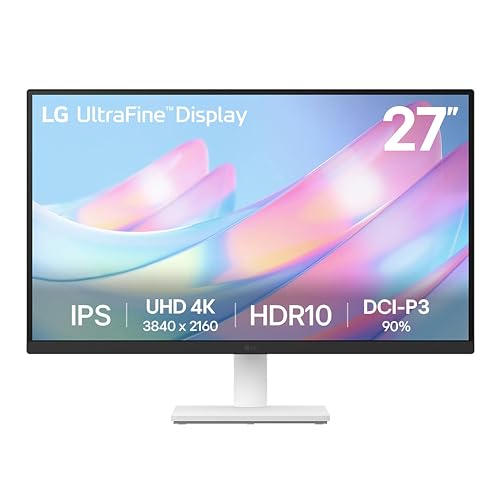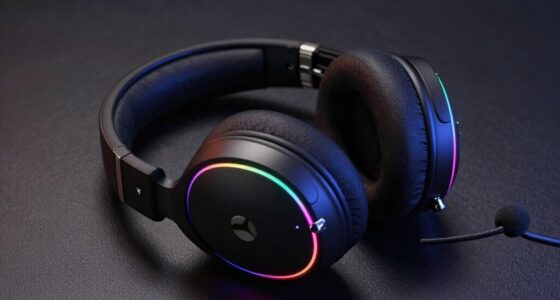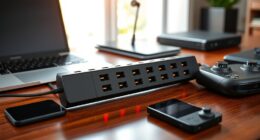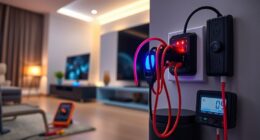If you want top-tier color accuracy for photo editing in 2025, I recommend checking out the best monitors like ASUS ProArt series, LG UltraFine, and Samsung’s borderless options. These displays offer wide color gamuts, precise calibration, and HDR support, making your work vibrant and consistent. They also come with ergonomic features and versatile connectivity. Keep exploring to find the perfect fit for your workspace and creative needs.
Key Takeaways
- Many models offer industry-standard DeltaE < 2 calibration for highly accurate color reproduction.
- Supports broad color gamuts like AdobeRGB, DCI-P3, and HDR standards, ideal for professional photo editing.
- Features include IPS panels, wide viewing angles, and high resolutions from 4K to 5K for detailed workflows.
- Connectivity options such as USB-C with Power Delivery and ergonomic stands enhance user flexibility.
- Designed for creative professionals, these displays combine precise calibration, advanced features, and premium build quality.
ASUS ProArt Display PA248QV 24.1” WUXGA Monitor
If you’re serious about photo editing, the ASUS ProArt Display PA248QV is an excellent choice because it offers industry-leading color accuracy right out of the box. Its 24.1-inch IPS panel provides sharp, detailed images with a resolution of 1920×1200 pixels, perfect for precise edits. With 100% sRGB and Rec.709 coverage, it guarantees vibrant, true-to-life colors. Calman verified and DeltaE < 2 assure consistent, accurate hues. Plus, the ergonomic features like tilt, pivot, swivel, and height adjustment make long editing sessions comfortable. Connectivity options include HDMI, DisplayPort, and USB ports, making it versatile for any workspace.
Best For: creative professionals, photographers, and designers seeking precise color accuracy and detailed visual performance.
Pros:
- Industry-leading color accuracy with 100% sRGB/Rec.709 coverage and DeltaE < 2 calibration
- Out-of-the-box image clarity with IPS panel technology for wide viewing angles
- Ergonomic adjustments (tilt, pivot, swivel, height) for comfortable long editing sessions
Cons:
- Slightly higher price point compared to basic monitors
- Limited to 24.1-inch size, which may not suit those needing larger displays
- Connectivity options may require additional adapters for certain setups
ASUS ProArt 27” 4K HDR Professional Monitor (PA279CRV)
The ASUS ProArt 27” 4K HDR Professional Monitor (PA279CRV) stands out as an ideal choice for professionals who demand precise color accuracy in their work. Its UHD 4K resolution, combined with an IPS panel, offers wide viewing angles and vibrant, consistent colors. With 99% DCI-P3 and Adobe RGB coverage, plus factory calibration to Delta E < 2, it guarantees highly accurate color reproduction. HDR support adds dynamic range for richer visuals. Extensive connectivity options, including USB-C with 96W Power Delivery, make it versatile. Ergonomic adjustments ensure comfortable setup, while Calman Verification confirms professional-grade color precision. This monitor is perfect for high-end photo and video editing workflows.
Best For: professionals in video editing, photography, and color-critical workflows who require high color accuracy and 4K resolution.
Pros:
- Excellent color accuracy with 99% DCI-P3 and Adobe RGB coverage, factory calibrated to Delta E < 2
- Wide viewing angles and vibrant visuals thanks to the IPS panel and 4K HDR support
- Extensive connectivity options, including USB-C with 96W Power Delivery and multiple input ports
Cons:
- Relatively heavy at 18.25 pounds, which may require sturdy mounting solutions
- Premium price point may be a consideration for budget-conscious users
- Limited to a 27-inch size, which might not suit users needing larger displays
ASUS ProArt Display PA247CV 23.8 Inch Monitor
Photographers and designers seeking precise color reproduction will find the ASUS ProArt Display PA247CV an ideal choice. This 23.8-inch IPS monitor delivers 178° wide viewing angles and supports 100% sRGB and Rec. 709 color gamuts, ensuring accurate, vibrant colors. Factory-calibrated with Calman verification, it maintains a Delta E below 2 for excellent color accuracy. Its versatile connectivity includes USB-C with 65W Power Delivery, HDMI, and USB 3.1 hubs, making it compatible with laptops and Macs. With LED backlighting for vivid visuals and a sleek black design, this monitor is perfect for professional editing workflows and reliable color precision.
Best For: creative professionals such as photographers and designers who require precise, accurate color reproduction and reliable visual performance.
Pros:
- Factory-calibrated with Calman verification ensuring Delta E < 2 for high color accuracy.
- Supports 100% sRGB and Rec. 709 color gamuts for vibrant, true-to-life colors.
- Versatile connectivity options including USB-C with 65W Power Delivery, HDMI, and USB 3.1 hub.
Cons:
- Full HD resolution (1920×1080) may be less sharp compared to higher-resolution monitors.
- Relatively large and heavy, potentially less portable for on-the-go use.
- Premium price point might be a consideration for budget-conscious users.
ASUS ProArt Display PA278QV 27” WQHD Monitor
For those seeking precise color reproduction in their photo editing workflow, the ASUS ProArt Display PA278QV stands out with its 27-inch WQHD IPS panel covering 100% sRGB and Rec. 709 color gamuts. It’s factory calibrated and Calman Verified, ensuring Delta E values below 2 for accurate colors straight out of the box. The monitor offers extensive ergonomic adjustments—tilt, pivot, swivel, height—and features an anti-glare coating to minimize reflections. With multiple connectivity options like HDMI, DisplayPort, DVI-D, and USB ports, plus ASUS’s ProArt presets and palette, it provides versatile customization. This monitor is a reliable tool for professional-grade photo editing in 2025.
Best For: creative professionals and photographers seeking precise color accuracy and versatile connectivity in a 27-inch WQHD IPS monitor.
Pros:
- Factory calibrated with Delta E < 2 for accurate colors straight out of the box
- Extensive ergonomic adjustments including tilt, pivot, swivel, and height for comfortable use
- Multiple connectivity options including HDMI, DisplayPort, DVI-D, and USB ports
Cons:
- Higher price point compared to basic monitors without professional calibration features
- Limited to 2560 x 1440 resolution, which may be less sharp than 4K displays for some users
- No built-in speakers, requiring external audio devices
ASUS ProArt 27” 5K HDR Monitor (PA27JCV)
If you’re serious about color accuracy in photo editing, the ASUS ProArt 27” 5K HDR Monitor (PA27JCV) offers exceptional features tailored to your needs. Its 5120 x 2880 resolution and IPS panel deliver sharp detail and wide viewing angles, ensuring consistent color from every angle. With a wide color gamut covering 99% DCI-P3, 100% sRGB, and 95% Adobe RGB, plus factory calibration to Delta E < 2, it guarantees precise, vibrant colors. Features like ambient light sensors maintain excellent brightness and temperature, while USB-C with 96W power delivery streamlines your workflow. This monitor is a reliable choice for professional content creators demanding top-tier color fidelity.
Best For: professional content creators and photo editors seeking exceptional color accuracy and high-resolution displays.
Pros:
- Factory calibrated to Delta E < 2 ensures precise and vibrant color reproduction.
- Wide color gamut coverage: 99% DCI-P3, 100% sRGB, 95% Adobe RGB, ideal for accurate editing.
- 5120 x 2880 5K resolution delivers sharp, detailed images with excellent clarity.
Cons:
- Relatively high price point may be a barrier for casual users.
- Large physical size (27 inches) requires ample desk space and ergonomic considerations.
- No built-in processor; requires connection to a compatible computer for use.
BenQ MA270U 27” 4K Monitor for MacBook® Pro/Air
The BenQ MA270U 27” 4K monitor is an excellent choice for anyone who needs precise color accuracy for photo editing, especially Mac users. It’s calibrated for Mac colors with a vibrant P3 wide color gamut, ensuring your edits are true to life. With dual USB-C ports delivering 90W power, I can connect and charge my MacBook seamlessly with a single cable. The monitor’s adjustable stand offers ergonomic comfort, and MacBook controls let me easily tweak brightness and volume. Supporting up to 3840×2160 resolution, this monitor delivers stunning detail, making it perfect for professional photo editing workflows.
Best For: creative professionals and Mac users who require precise color accuracy, high-resolution display, and seamless connectivity for photo editing and multimedia work.
Pros:
- Calibrated for Mac colors with a vibrant P3 wide color gamut ensuring true-to-life image reproduction
- Dual USB-C ports with 90W power delivery for single-cable connection and charging of MacBook and accessories
- Adjustable ergonomic stand with height, tilt, swivel, and pivot features for customized comfort
Cons:
- Relatively heavy at approximately 30.5 pounds, which may affect portability or desk placement
- Premium price point reflecting high-end features and color calibration
- Limited availability prior to October 2, 2024, as it is a new release in the series
BenQ PD3205U 32″ 4K UHD Monitor
Designed with professional photo editors in mind, the BenQ PD3205U 32″ 4K UHD monitor delivers exceptional color accuracy out of the box. It’s factory-calibrated with a validation report, supporting 99% sRGB and Rec.709 gamuts, and boasts an average Delta E ≤3 for precise color reproduction. The monitor features AQCOLOR technology, ensuring trustworthy colors for critical work. Its ergonomic design allows tilting, pivoting, swiveling, and height adjustments for comfort. With seamless connectivity options like HDMI, DisplayPort, and USB-C with 65W power delivery, it’s versatile for any workflow. Built-in speakers and a HotKey Puck complete the setup, making it a reliable choice for professional photo editing.
Best For: professional photo editors and designers seeking precise color accuracy and versatile connectivity in a 4K UHD monitor.
Pros:
- Factory-calibrated with validation report supporting 99% sRGB and Rec.709 for accurate color reproduction
- Ergonomic design with tilt, pivot, swivel, and height adjustments for personalized comfort
- Seamless connectivity options including HDMI, DisplayPort, and USB-C with 65W power delivery
Cons:
- Slightly heavy at 20.7 pounds, which may require sturdy mounting options
- Premium features may come at a higher price point compared to basic monitors
- Limited information on built-in speaker quality and external audio options
ASUS ProArt Display PA279CV 27” 4K HDR UHD Monitor
For photo editors who demand precise color reproduction, the ASUS ProArt Display PA279CV stands out as an excellent choice. Its 27-inch 4K HDR UHD IPS panel delivers vibrant, accurate colors with a Delta E under 2, ensuring reliable color consistency right out of the box. Supporting 100% sRGB and Rec. 709 standards, it covers a wide color gamut perfect for professional work. Factory calibration, combined with extensive connectivity options like USB-C with 65W Power Delivery, makes it versatile and easy to integrate into any creative setup. Plus, the included three-month Adobe Creative Cloud subscription adds value, making this monitor a smart investment for serious photo editors.
Best For: professional photo editors and creative professionals who require precise color accuracy and vibrant, consistent image reproduction.
Pros:
- Factory-calibrated with Delta E < 2 for reliable color accuracy out of the box
- Supports wide color standards: 100% sRGB and Rec. 709 for versatile professional use
- Extensive connectivity options including USB-C with 65W Power Delivery for easy setup and device charging
Cons:
- Higher price point may be a consideration for budget-conscious buyers
- Limited to 27-inch size, which may not suit those needing larger displays for multitasking
- Requires compatible hardware to fully utilize HDR and 4K features
LG 27US500-W 27-Inch 4K UHD Monitor
If you’re a digital artist or photographer seeking precise color reproduction, the LG 27US500-W is an excellent choice. Its 27-inch 4K UHD display offers stunning detail and vibrant colors, thanks to HDR10 support and a wide 90% DCI-P3 color gamut. The IPS panel guarantees consistent, accurate colors from any angle, making it ideal for editing work. The monitor’s contrast ratio of 1000:1 delivers deep blacks and bright highlights, while its ergonomic stand and borderless design improve workspace comfort and aesthetics. With HDMI and DisplayPort options, plus features like Reader Mode and Flicker Safe technology, it’s a reliable, user-friendly option for color-critical tasks.
Best For: digital artists, photographers, and creative professionals seeking precise color accuracy and detailed 4K visuals.
Pros:
- Offers stunning 4K UHD resolution with vibrant HDR10 support for accurate color reproduction.
- IPS panel ensures consistent, accurate colors from any viewing angle.
- Ergonomic stand and borderless design enhance workspace comfort and aesthetics.
Cons:
- 60Hz refresh rate may not be ideal for fast-paced gaming.
- Limited to HDMI and DisplayPort connectivity, lacking additional ports like USB-C.
- Response time of 5ms might be less suitable for high-speed gaming or fast-moving visuals.
INNOCN 27 Inch 4K Monitor with USB C and HDR400
The INNOCN 27 Inch 4K Monitor with USB C and HDR400 stands out as an excellent choice for photo editors who demand precise color reproduction. Its 3840×2160 resolution on a 27-inch IPS panel ensures sharp, detailed images with wide viewing angles. With ∆E<2, it delivers accurate colors, while HDR400 enhances contrast and color vibrancy for more realistic editing. The monitor’s USB-C port supports 65W power delivery, streamlining connectivity to laptops and devices. Adjustable ergonomic features, VESA compatibility, and a frameless design make it versatile and comfortable for long editing sessions. Overall, it’s a reliable, feature-rich option for elevating your photo work in 2025.
Best For: photo editors and creative professionals seeking precise color accuracy, high resolution, and versatile connectivity for detailed editing work.
Pros:
- 3840×2160 4K UHD resolution delivers sharp, detailed images perfect for editing and design.
- Supports HDR400 for enhanced contrast and vibrant colors, improving realism in visual work.
- USB-C port with 65W power delivery simplifies connections to laptops and devices, reducing cable clutter.
Cons:
- 60Hz refresh rate may not be ideal for fast-paced gaming requiring higher refresh rates.
- Slightly heavy at 17.21 pounds, which might make repositioning less convenient.
- Limited to VESA 75×75 mm mount compatibility, which may restrict mounting options for some users.
Samsung 32″ UJ59 4K UHD Computer Monitor
The Samsung 32″ UJ59 4K UHD monitor stands out as an excellent choice for photo editors who need accurate, vibrant colors. Its 3840×2160 resolution delivers sharp, detailed images, while the VA panel supports over a billion shades for true-to-life visuals. Seamless UHD upscaling improves lower-resolution content, and wide viewing angles ensure consistent color accuracy from different perspectives. Features like Game Mode, Picture-by-Picture, and Picture-in-Picture boost productivity and multitasking. With sleek design, HDMI 2.0, DisplayPort, and a sturdy stand, this monitor combines impressive visuals with practical connectivity, making it a versatile option for professional photo editing.
Best For: photo editors and multimedia professionals seeking a high-resolution monitor with accurate, vibrant colors and versatile connectivity.
Pros:
- Stunning 4K UHD resolution with sharp, detailed images
- VA panel supports over a billion shades for true-to-life visuals
- Features like UHD upscaling, wide viewing angles, and multitasking options (PBP, PIP)
Cons:
- Slightly heavier and larger, which may require ample desk space
- Limited to HDMI 2.0 and DisplayPort, lacking newer connectivity options
- Customer reviews indicate some users experience occasional color calibration issues
BenQ SW321C 32″ 4K UHD Photo Video Editing Monitor
BenQ’s SW321C 32″ 4K UHD monitor stands out as an ideal choice for professional photographers and video editors who demand top-tier color accuracy. Its 32-inch IPS panel delivers precise, consistent colors supported by factory calibration and a detailed report. Covering 99% AdobeRGB, 100% sRGB, and 95% DCI-P3, it ensures vibrant, true-to-life images. Hardware calibration with a 14-bit 3D LUT, along with CalMan verification and Pantone SkinTone validation, guarantees professional-grade precision. Features like USB-C with power delivery, extensive ergonomic adjustments, and Paper Color Sync technology make this monitor a versatile, reliable tool for achieving flawless visual results in photo and video editing.
Best For: professional photographers and video editors who require precise color accuracy and reliable performance for their creative work.
Pros:
- Factory calibrated with reports included for assured color accuracy
- Supports extensive color gamuts: 99% AdobeRGB, 100% sRGB, and 95% DCI-P3
- Hardware calibration with a 14-bit 3D LUT and professional validation (CalMan, Pantone)
Cons:
- Higher price point may be a barrier for some users
- Large size and premium features could be overkill for casual or non-professional use
- Limited gaming or multimedia features, focusing primarily on color accuracy and editing capabilities
Digital Kolor Pro 16:9 Large Color Calibration and Video Chip Chart, 2-Pack
If you’re serious about achieving accurate color in your photo editing and video work, the Digital Kolor Pro 16:9 Large Color Calibration and Video Chip Chart is an essential tool. These two heavyweight charts measure 14 x 7.88 inches and are designed for precise calibration. Each side offers features like color targets, gray scales, NTSC color bars, and framing apertures for HD, SD, and square formats, making them versatile for various workflows. They help set white balance, exposure, and evaluate color saturation. Made in the USA, these charts are perfect for professional video, digital photography, and multi-camera setups, ensuring consistent, accurate color output across your projects.
Best For: professional photographers, videographers, and broadcasters seeking precise color calibration and exposure accuracy for high-quality digital video and photography projects.
Pros:
- Includes dual-sided charts with comprehensive color targets, gray scales, NTSC color bars, and framing guides for versatile calibration needs.
- Designed specifically for HD, SD, and square formats, ensuring compatibility across various video and photography workflows.
- Made in the USA with heavyweight, durable paper, suitable for professional use and long-term calibration tasks.
Cons:
- Slightly larger and heavier than some portable calibration tools, which may be less convenient for on-the-go use.
- Requires familiarity with waveform and vectorscope tools for optimal use, potentially challenging for beginners.
- Price may be higher compared to basic calibration charts or digital calibration apps, making it more suitable for professional environments.
Samsung 27” Borderless Business Monitor (LS27D402GANXGO)
For photographers and digital artists seeking precise color representation, the Samsung 27” Borderless Business Monitor (LS27D402GANXGO) is a solid choice. Its 27-inch IPS panel delivers vivid, consistent colors with minimal washout, even at different angles. The full HD resolution ensures sharp details, while the 100Hz refresh rate provides smooth motion for editing videos or gaming. Features like Eye Saver Mode reduce blue light and flicker, protecting your eyes during long editing sessions. The slim, borderless design maximizes screen space, and ergonomic adjustments like height and pivot make it adaptable to your workspace. Overall, it’s a versatile monitor suitable for professional photo editing, gaming, and multimedia tasks.
Best For: professionals, gamers, and multimedia enthusiasts seeking a versatile, high-quality 27-inch monitor with accurate color and smooth performance.
Pros:
- Vivid, consistent colors with minimal washout thanks to the IPS panel
- Smooth performance with a 100Hz refresh rate ideal for gaming and video editing
- Ergonomic features like height adjustment and pivot for comfortable viewing angles
Cons:
- Full HD resolution may be less sharp compared to 4K options for detailed editing
- Slightly heavier design at 8.82 pounds, which could impact portability
- Limited to a 1920×1080 resolution, which might not meet the needs of users requiring higher detail
LG 32UN650-W 32-Inch UHD Monitor
The LG 32UN650-W 32-Inch UHD Monitor is an excellent choice for photo editors who need precise color reproduction. Its 32-inch IPS display offers 3840 x 2160 resolution with 178° wide viewing angles, ensuring consistent, vibrant colors from any perspective. Supporting HDR10 and DCI-P3 95%, it delivers accurate, rich visuals essential for photo editing. The monitor’s 1.07 billion color depth guarantees smooth gradients and fine detail. Its ergonomic design includes height adjustment and a virtually borderless frame, making it comfortable for long editing sessions. Overall, this monitor combines size, clarity, and color accuracy, making it a versatile tool for professional photo work.
Best For: creative professionals and photo editors who require precise color accuracy and stunning visuals for detailed work.
Pros:
- 32-inch UHD IPS display with wide 178° viewing angles ensures consistent color and clarity from any position
- Supports HDR10 and DCI-P3 95% for accurate, vibrant color reproduction ideal for photo editing
- Height-adjustable stand and virtually borderless design enhance ergonomic comfort and aesthetic appeal
Cons:
- Relatively large size may require ample desk space and proper setup considerations
- 5ms response time, while suitable for most tasks, may not meet high-end gaming performance standards
- Limited connectivity options details are not specified, which could impact compatibility with certain devices
Factors to Consider When Choosing Color‑Accurate Displays for Photo Editing

When selecting a color‑accurate display for photo editing, I consider several key factors to guarantee quality results. Things like color gamut coverage, calibration standards, resolution, connectivity, and ergonomic features all play a crucial role. Understanding these points helps me choose a monitor that meets my editing needs effectively.
Color Gamut Coverage
A wider color gamut coverage, such as 99% AdobeRGB or DCI-P3, is crucial for achieving vibrant and accurate colors in photo editing. It allows for more precise color reproduction, making subtle shades and gradations look natural and realistic. Covering 100% of sRGB and Rec.709 ensures your work remains consistent across digital platforms and workflows. High color gamut support helps prevent color clipping, preserving the integrity of your images’ hues. This extensive coverage is essential for matching print, display, or broadcast standards, ensuring your edits translate well across media. With a broader gamut, you can confidently refine your photos, knowing the colors you see are true-to-life and detailed. Ultimately, solid color gamut coverage elevates your editing precision and the quality of your final output.
Calibration Accuracy Standards
Achieving accurate color reproduction isn’t just about having a wide color gamut; it also depends on how well the display is calibrated. For photo editing, a Delta E of less than 2 is vital to guarantee precise color matching. Many professional monitors come factory calibrated and Calman verified, meeting strict industry standards for calibration accuracy. Coverage of color gamuts like 100% sRGB and Rec. 709 is also essential for consistent results. Hardware calibration using a 14-bit or higher 3D LUT helps maintain long-term accuracy and stability. Regular calibration and verification are necessary to uphold these standards, especially for professional work. Staying within these calibration accuracy benchmarks ensures that your colors are true to life, making your edits more reliable and consistent over time.
Resolution and Size
Choosing the right display for photo editing means considering both resolution and size to guarantee accurate results. Higher resolutions like 4K or 5K deliver more detail and clarity, making it easier to spot fine nuances in your images. A minimum of 1920×1080 (Full HD) is essential, but professional work benefits from 2560×1440 (QHD) or higher. Larger screens, 27 inches or more, provide a broader workspace, allowing for easier fine-tuning without feeling cramped. Ultra-high-resolution monitors enable smoother multitasking and detailed color adjustments without pixelation or loss of fidelity. When resolution and size are well-matched, you get a more accurate preview of your edits, reducing the need for constant zooming or panning, and ensuring your work looks as intended across different devices.
Connectivity Options
When selecting a color‑accurate display for photo editing, ensuring it has versatile connectivity options is essential to streamline your workflow. Look for monitors with multiple ports like HDMI, DisplayPort, and USB-C to connect seamlessly with various devices. USB-C ports supporting Power Delivery of at least 65W simplify your setup by allowing single-cable connection and charging. An extensive array of USB 3.0 or USB 3.1 ports built into the monitor’s hub is a plus for connecting peripherals like external drives or graphic tablets. It’s also wise to choose displays compatible with both Windows and Mac systems, ensuring flexibility. Additionally, adjustable connectivity setups, such as daisy-chaining multiple monitors via DisplayPort or USB-C, can greatly enhance your workspace’s expandability and efficiency.
Ergonomic Adjustments
Once you’ve verified your display has versatile connectivity options, it’s equally important to take into account its ergonomic features. Adjustable tilt, pivot, swivel, and height options allow me to position the monitor for maximum comfort, reducing strain during long editing sessions. A flexible stand helps maintain proper viewing angles, which minimizes eye fatigue and encourages better posture, essential for sustained productivity. Proper ergonomic setup ensures consistent viewing conditions, cutting down glare and reflections that can distort color perception. Monitors with these features let me customize the workspace to suit my workflow, boosting precision in color-critical tasks. Adjustable positioning also helps me stay focused and comfortable, leading to more accurate color assessment and higher-quality editing. Ergonomic adjustments are vital for both comfort and maintaining the integrity of my work over time.
Price and Brand Reliability
Ever wondered why some displays maintain consistent color accuracy over time? It’s often due to the brand’s reputation and build quality. Reputable brands with a proven track record tend to deliver more reliable color performance and durable components, minimizing shifts in accuracy. Higher-priced monitors usually include professional calibration, factory color standards, and high-quality materials, which help keep colors stable over years. Conversely, budget options might lack comprehensive calibration options or industry-standard color coverage, risking compromised photo editing precision. Certified displays verified by standards like Calman or Pantone typically come from trusted brands and reflect fair pricing for quality. Investing in reputable brands also means better after-sales support, warranties, and firmware updates, ensuring your display’s color performance remains consistent long-term.
Frequently Asked Questions
How Does Ambient Lighting Affect Color Accuracy During Editing?
Ambient lighting considerably impacts my color accuracy during editing. When the room has harsh or uneven lighting, I notice colors appear off or inconsistent, making it harder to judge true hues. I prefer neutral, dim lighting to minimize reflections and color shifts. Consistent ambient conditions help me work precisely, ensuring my edits look perfect across different environments. Proper lighting is essential for maintaining true color accuracy and achieving professional results.
What Is the Typical Calibration Frequency for Professional Photo Monitors?
I usually calibrate my professional photo monitor every two to four weeks to guarantee color accuracy stays consistent. Sometimes, I calibrate more often if I notice shifts in color or if I change the ambient lighting. Regular calibration is essential because monitors can drift over time, and maintaining a reliable color profile helps me produce accurate edits and consistent results, especially for critical print or client work.
Are There Specific Color Gamuts Better Suited for Printing Versus Digital Display?
Yes, I find Adobe RGB is better for printing because of its wider color range, capturing more details that can be reproduced in print. For digital displays, sRGB is usually sufficient and offers excellent compatibility across devices. When I work on projects intended for both, I often start in Adobe RGB and then convert to sRGB for web use, ensuring my colors stay consistent across platforms.
How Important Is Uniformity Across the Screen for Accurate Color Editing?
Having a uniform display is absolutely essential for accurate color editing. When your screen’s colors shift across different areas, it’s like trying to hit a moving target—your work becomes inconsistent. I’ve learned that a display with excellent uniformity helps me trust what I see, ensuring my edits translate well across devices and prints. Without it, you’re just chasing your tail, trying to make sense of what isn’t truly there.
Can Hardware Calibration Tools Be Integrated With Software for Better Accuracy?
Yes, hardware calibration tools can be integrated with software to improve accuracy. I use calibration devices that come with dedicated software, allowing me to fine-tune my monitor’s colors precisely. This integration guarantees consistent, reliable results and simplifies the calibration process. By combining hardware and software, I achieve a level of color fidelity that’s essential for professional photo editing, giving me confidence my work looks great across all displays.
Conclusion
Choosing the right color‑accurate display can truly transform your editing workflow. As I explored these options, I realized how each monitor’s unique features might perfectly align with your needs—whether it’s precision, size, or budget. Sometimes, the best tool appears when you least expect it, just like stumbling upon a hidden gem. So, trust your instincts, consider your priorities, and you might just find that perfect display that elevates your work in ways you never imagined.


























